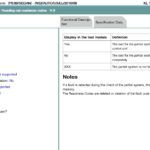The BMW E36, a classic beloved by enthusiasts, often requires delving into its Digital Motor Electronics (DME) for tuning and diagnostics. This guide explores how to access and understand the E36’s OBD2 DME using INPA software and the necessary hardware.
Accessing the E36 DME: Software and Hardware
For effective E36 DME interaction, you’ll need specific software and hardware:
-
INPA Software: This BMW diagnostic software is crucial for reading and interpreting DME data. It’s often recommended to run INPA on a dedicated laptop with Windows XP for optimal compatibility. While attempts to run it on later Windows versions or virtual machines are possible, XP provides the most stable environment. A reliable download link for INPA can often be found within dedicated BMW forums.
-
Cables: Two types of cables are essential:
- Round Pin Cable: This 20-pin connector allows direct communication with the DME for flashing and tuning.
- OBD2 Cable: This cable connects to the standard OBD2 port for diagnostics related to the instrument cluster, such as odometer readings, airbag (SRS) resets, and unit conversions. Specific USB to OBD2 adapters are required for compatibility with INPA, with certain chips (often those compatible with VW vehicles) working best. Building your own adapter is possible, but purchasing a pre-made cable is generally recommended for simplicity. Adapters for the round pin connector are also available.
Understanding DME Tuning
Tuning the E36’s DME involves adjusting various parameters to optimize performance. This process requires understanding how the DME operates and the implications of changing specific values.
-
Fuel Mapping: Similar to tuning with MegaSquirt, adjusting the fuel map in the DME requires careful consideration of engine load and RPM.
-
Adaptive Learning: The E36 DME has adaptive learning capabilities, meaning it adjusts fuel/air ratios based on driving conditions and sensor inputs. This requires a iterative tuning process: make adjustments, drive the car, analyze data logs, and make further refinements. The goal is to achieve base values that minimize the need for DME corrections, allowing the system to effectively adapt to environmental changes and fuel quality variations.
-
Other Adjustments: Beyond fuel mapping, the DME allows control over various parameters like idle speed, cold start behavior, and more. Understanding how each parameter affects engine performance is crucial.
Navigating the Tuning Community
The E36 tuning community, often found within dedicated forums, provides invaluable resources. However, certain etiquette and rules should be observed:
-
Thorough Research: Before asking questions, thoroughly search existing threads. Many common questions have already been answered extensively.
-
Respect and Politeness: Engage respectfully with other members. Avoid making comparisons to other car models that might offend.
-
Intellectual Property: Respect the intellectual property of tuners. Avoid requesting or sharing tune files, as this often violates copyright and undermines the work of professional tuners.
-
Sensitivity to Legality: Refrain from discussing modifications related to emissions or other legally restricted areas. Focus on performance enhancements within legal boundaries.
Conclusion
Accessing and understanding the E36’s OBD2 DME opens up a world of possibilities for diagnostics and performance tuning. Utilizing INPA software, the correct cables, and a respectful approach to the online community provides the foundation for a successful E36 tuning journey. Remember to prioritize thorough research, ethical practices, and a deep understanding of the DME’s functionalities.

